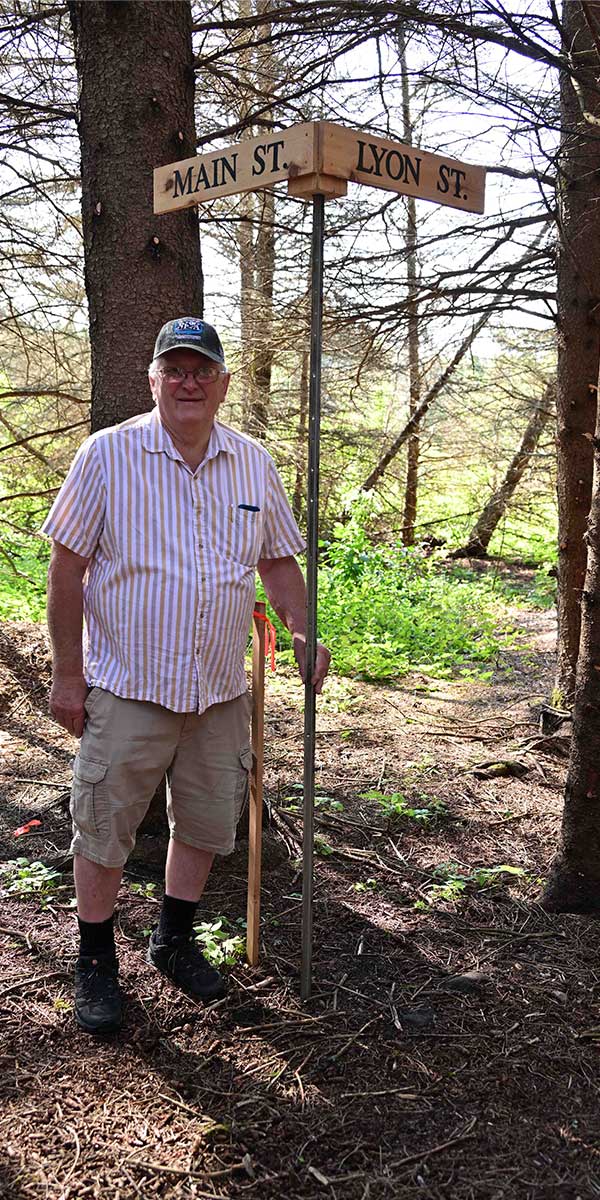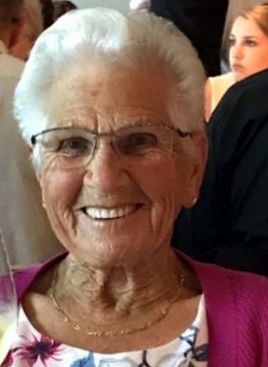By Petra Wall
MICHAEL’S BAY—Michael’s Bay Historical Society members have been extra busy lately, working to slowly recreate part of the old community where the thriving Michael’s Bay town once stood. They have been erecting street signs and clearing trees in the areas where the ‘ghost’ town’s vital services and homes once stood.
On August 26, the public was invited to tour the site and enjoy a picnic where a village of 150 folk at the start grew to 400 settlers at the height of the lumbering activity. Early Michael’s Bay had all the vital services. Many new immigrants to the area, gravitated to the fast-growing town and many of the inhabitants never left. They are buried there in five graveyards of five denominations. Names of the residents can be found in old binders that are on display here today and normally, at the South Baymouth Museum.
The traffic on Government Road was a bit heavier that day. People were arriving and forming groups. About 200 to 250 visitors would arrive. An old gravel pit was designated as the parking lot. An ATV was waiting to help members who might have had a problem walking to the site from there. As the groups formed, a member of the Historical Society introduced himself and slowly walked with the visitors to the site of the old town. Many of the Now and Then stories in The Expositor featured fathers and sons who spent several years working at the mill and supporting the lumbering that took place here.
Big ships would nestle up to the long wharf that was a focal point for the bay. They left with squared-off lumber that would be delivered to many cities bordering the Great Lakes, like Goderich, Port Huron and Chicago where a fire had destroyed much of the city. Many newcomers to the island found jobs here, jobs that would give them the opportunity to buy their own land and build a home. Many stayed at Michael’s Bay. Those who did choose to leave stayed just long enough to sponsor their own stake in another part of the island.
Ed Sagle, a past president of the Society shared his perspectives to those present at 10:30 am. “A Mr. Lyon was in possession of the first timber rights here and he had paid $200 for them. He owned a big house, the first on the street that was named after him. Near his home was a bakery and a butcher shop. A Baptist cemetery was established also. Where these houses and buildings were in the 1800s and beyond, only grass, trees and some random plots of asparagus remain today.”
“At one time, the King St. bridge here, crossed the Manitou River to more houses and an Anglican cemetery on the other side. Much later, when the town was slowly being scaled down, the lumber from the old board and batten buildings was salvaged. Part of my house on Highway 6 had an old addition. I believe these boards were taken from one of the abandoned buildings in the town. They had square nails embedded in the wood. The houses were all ‘’board and batten. There was only one log home, the Murray home.”
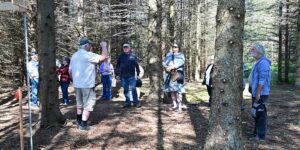
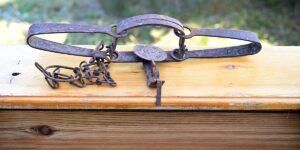
Ed shared some local folklore. “If you are very quiet at midnight when there is a full moon, you can hear a lumberjack slowly drag his axe across the bridge.”
When the walkers reached the top of the hill, they found bright blue canopies had been mounted for the visitors to provide shelter for their picnic lunches. At this site, other important buildings had been erected many years earlier: a big general store, a blacksmith shop, two to three boarding houses and a school. The school had been situated just behind the apple tree that was still there today. The blacksmith’s shop sat at Kate and Main Streets. In the nearby riverbed, the footings of a wooden tramway that ran to the long dock, could still be seen close to the mill, near the falls. The saw in the mill had a vertical structure. The blade, run by the water from the flowing river, moved up and down. At the height of the season, it was often running 24 hours a day. Most logs arrived by the river. Some logs were brought in by horse and sleigh in the winter. As mentioned, the mill produced large square chunks of lumber that could be easily and economically stored on a ship and then milled for more definitive needs in the big cities. A shingle mill was also powered by the stream. Wood was not wasted. The entire tree was used. Branches and smaller trees could be cut into blocks and incorporated into the roads.
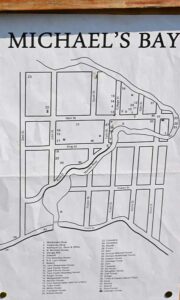
The Michael’s Bay Historical Society was formed in 2000 and Eleanor Lentir, mother of Ben Lentir, the current president of the Historical Society, was a founding member. “It took a year to register the society with the government,” Eleanor shared. “We are hoping to rebuild some of the buildings and clean up the cemeteries. On a personal note, my grandmother Martha Leeson lived on Hwy 6. As a young girl of six or seven, she would walk alone from her house once a week, carrying eggs to be sold at the general store in Michael’s Bay.”
Displayed under one of the blue canopies, were some old relics from days gone by, like a trap for animals, a butter churn, and many quilts in an old chest. Ten-dollar memberships for the Society were also being sold by Jane Tilston and people were lining up to get theirs.
Several visitors had connections to the old town. Leonard St. Louis shared a bit of his personal history, “My great-great grandfather Michael Hagen was a blacksmith here. He married his second wife Mary Ann Stephens at Michael’s Bay. Michael Hagen’s son from the first marriage was William Duncan Hagan who married Alena Bisson of Providence Bay. Alena and Duncan’s daughter Mary Philomene Hagan was born in Providence Bay in 1879 and baptized in Wikwemikong. She was about one year old when her father died. William was killed sometime between 1879 and 1881, trying to free a log jam in the water. It is assumed he is buried here.”
“Mary Philomene Hagan, my grandmother, was later wed to Herman St. Louis, a miner at Victoria Mines, also a ghost town today. My parents are Annabelle and Albert St. Louis. Albert was the youngest of ten siblings. He was overseas, working as a radio officer on three Merchant Navy ships. He was awarded the Atlantic Star for his service,” Leonard continues. “I was trained as a Class A auto mechanic, and I taught technical students in the Ontario secondary school systems. This included how to repair small engines. I finished my career with the Ministry as an education officer, working for the Curriculum Assessment Policy Branch in Toronto.”
Laura (Clarke) Middlebrook shares that her “Grandparents Ivan and Harriet Clarke had 12 kids and they had a boarding house in the Michaels Bay community. Ivan was a mechanic and a ‘jack of all trades.’ After the fire, they moved to Manitowaning where Ivan was a mechanic and a carpenter. Her father was born there, and he sailed with his father for a few years.”
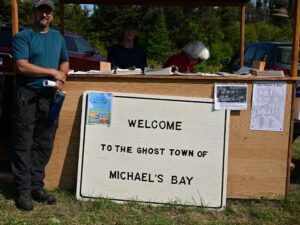
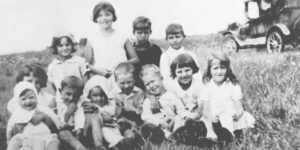
Burke Pennie’s grandfather John Pennie lived and worked in the lumber camp here, and other lumber camps after it closed. “I fished here as a teenager,” he adds.
Esther Spadzinski was an original charter board member of the Michael’s Bay Historical Society. “Great-grandmother Ellen Martin worked in the General Store at Michael’s Bay. She was married to John Russell. I still have a set of dishes, a tea set, purchased from the store. I posted a picture of my father when he was attending a picnic at Michael’s Bay in the 1930s. It’s on the Facebook page for the Michael’s Bay Historical Society.”
Overall, it was an interesting trek back into the historic era of Michael’s Bay, when the trees that populate the setting then, had been replaced with vital services, including a school, a general store, a blacksmith, five graveyards and a vital mill that cut the wood for many projects around the periphery of the Great Lakes. It was also a crucial time for new immigrants to find their first jobs and enough money to build their own homes on their own land. It was indeed a significant part of the history of our Manitoulin Island.

